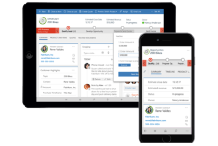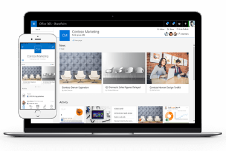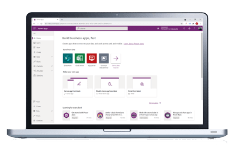Summary
Advanced options in Office 365 Microsoft Project can often add another level of customization project managers add to their project management tools to help manage projects. Custom fields, for instance, may be used to display colored graphical indicators to quickly communicate the status of the status of tasks in the project with regard to cost or schedule. Calculated custom fields in MS Project may be created to calculate the amount of hours a specific resource type is assigned in the project.
In addition to fields, custom views may also be created which help to view project portfolios. Creating a custom view which displays the fields you want in the order you want can often help streamline and simplify your ability to analyze project information and task list.
Once created these custom views (and tables) may be copied from project to project. These items and more will be covered in this Microsoft Project Training Webinar. Note, the information in the webinar is application to various versions of MS Project.
By the end of this session students will learn how to leverage some of the more common advanced features of Microsoft Project to help analyze project and resource information in their projects.
Advanced Options with Microsoft Project
Creating custom Fields and Look up Tables in MS Project
Custom look up tables and fields can be created in Microsoft Project to capture data. Custom fields can display task or resource attributes as text fields, indicators and they can be calculated by a formula.
To create a custom field in MS Project:
- Select the MS Project ribbon and click on Custom Fields
- Choose whether the custom field will be a task or resource field
- Select the data Type in the drop down, it defaults to text
- Select the text field, there are 30 available fields
- Click on Rename to change the name from the default Text1
- Select the Lookup radio button to create a lookup table
- Choose None in the Calculation for task and group summary rows
- Choose None for Calculation for assignment rows
- Choose Graphical Indicators for Values to display (use Data to display the text for the lookup table)
- Add the new field to a view
Applying Formulas in Microsoft Project
To apply a formula to a custom field:
- Follow the steps to create the custom field
- Select the formula radio button
- Locate the field in the Field drop down box
- Create the graphical indicators
- Click OK
- Insert the new field in to a view
Creating Custom Tables and Views in Microsoft Project
Custom tables can be created to display the custom views created.
To create a custom table:
- From the View ribbon click on Tables | More Tables
- Select Task or Resource
- Click New
- Rename the table
- Check the Show in menu box
- Select the fields for the table
- Click OK to save the table
- From the View ribbon select Other Views | More Views | New
- Choose from Single view or Combination and click OK
- Define the new view, choose a naming convention that identifies the view as a custom view
- Check the Show in menu box so the view is listed in the drop down menu
- Click OK to save
Formatting Views in MS Project Professional
Formatting a view can change how the data is presented to highlight key tasks or identify the critical path in your project schedule.
To create a custom grouping:
- From the View ribbon select the drop down in the Data box to select a default grouping
- Select More Groups | New to create your own grouping format
- Name the new grouping and select how the view should be grouped by
- Click Save
- Click the highlight drop down to highlight text that meets certain criteria in the task table
- Click the Filter drop down to filter the view
- Use an existing filter or create new one
- Select the Field Name, Test, and Value(s)
- Click Save
Use the Format ribbon to continuing modifying the view.
- Click on Text Styles to change the font style for selected tasks
- Click on the Format paint bucket drop down and select bar styles to change the Gantt bars
- Select a different Gantt Chart Style to change the color for all Gantt bars
Using the Organizer to Copy Fields, Tables and Views in Microsoft Project
The Organizer is a tool you can use to copy reports, calendars, tables, views and other elements to other projects. Project’s default behavior is to copy all new
iews and related elements you create to the Global template.
To change this behavior:
- Click on File | Options | Advanced
- Deselect the checkbox Automatically add new views, tables, filters, and groups to the global
If you have unchecked this setting and wish to copy elements from one project to another:
- Click File | Organizer
- Select the element from the open project and copy it to the Global template
- Once it is copied to the Global template, the element will be available to copy in to other projects
Shared Resource Pools in Microsoft Project Professional
When managing multiple project schedules in Microsoft Project it often helps to understand the impact on resources across all the schedules. Especially if the same resources will be working on more than one of the involved schedules.
For example, if resource “A” has 3 assignments in three different projects that are all occurring at the same time, this is something you as the Project Manager will need to know. Because if the resource is fully allocated in each of the three projects you may have an overallocation issue. Conversely, the opposite could be true where a resource is underallocated.
The plans linked to a resource pool with Microsoft Project are called sharer plans. Plans may be linked at any time. It makes the most sense to link all new plans to the resource pool and make them sharer plans.
This makes resource information instantly available which helps in assessing resource utilization more immediate. Some benefits of a shared resource pool include:
- A change to a resources’ working time is reflected against all plans immediately that are using the shared resource pool.
- Overallocations are more easily identified since the resource pool is shared across multiple project plans.
- Resources’ cost and assignment information may be viewed in a single location.
Consider the above benefits when working with multiple Project Managers across a network. Project plans and the resource pool file would be stored in a network location accessible by all Project Managers. This way all Project Managers would benefit from the information provided by the shared Resource Pool.
There are several ways to create a resource pool file in Microsoft Project. Basically you would open a new blank project, apply the Resource Sheet view, and then type the names of all the resources required, along with all required information such as rate, resource attributes, and working time.
Managing Master Projects with Microsoft Project
A master project, also referred to as a program, is a project that contains inserted projects. The inserted projects are called subprojects. In Microsoft Project, Master projects are used to consolidate smaller projects that may be managed by other project managers or to create detailed reporting views for multiple projects.
By default, MS Project treats the subprojects as summary tasks in the master project to allow for a single critical path.
To view multiple critical paths within the master project:
- Click on File | Options | Schedule
- Deselect the checkbox Inserted projects are calculated like summary tasks
- Click OK
To create a master project:
- Open the project that will become the master project or start from a Blank project
- Click on the row below the task where you wish to insert the subproject
- From the Project ribbon click on Subproject
- Locate the subproject and click Insert
Creating Dependencies Across Projects in MS Project
- Expand the subproject to view all the inserted tasks
- Using control click select in the correct order the tasks you wish to link together
- From the Task ribbon click on the Link selected tasks command
Note: The link in the predecessor column referencing the external project.
To remove a subproject from a master project:
- Highlight the project summary task row for the subproject and right click
- Select Delete Task
- Click OK to delete all the sub tasks to remove the subproject from the master
Note: This will not delete the subproject, it will just remove it from the master project.
Creating a Shared Resource Pool in Microsoft Project
A resource pool is a separate project that only contains resource information in MS Project. The resource pool provides a centralized place for the resource manager to maintain resource information such as resource names, rates and maximum units.
The projects that use the resources listed in the resource pool are sharer files. The sharer file is a project with tasks, duration, and work.
To create a resource pool in MS Project:
- Open a blank project
- Navigate to the Resource Sheet view
- Enter all of the resources available for assignment in your organization including the rates, maximum units and other attributes
- Save the file with the naming convention of Resource Pool
To share resources with the resource pool:
- Open the Resource Pool project
- Open the sharer file
- From the Resources ribbon in the sharer file, select Resource Pool | Share Resources
- Select Use resources From: Resource Pool
- Select which project takes precedence for conflicts (if the rates are different in the Resource Pool from the sharer file which one should be applied), Pool takes precedence will apply the resource calendar and information in the Resource Pool project
- Click OK
- Assign resources to tasks in the sharer file
- Save and Close the sharer file
- Save and Close the Resource Pool
When opening the resource pool there will be options to choose from. The default is to open read-only. This allows others to work on project plans connected to the resource pool.
If you need to edit the resource pool select the second radio button. This will let you directly save edits to the resource pool while preventing other sharer files from editing the resource pool at the same time.
To disconnect a project from the resource pool:
- Open the sharer file
- From the Resource ribbon select Resource Pool | Share Resources
- Select the first radio button to Use own resources
- Click OK
Related links















